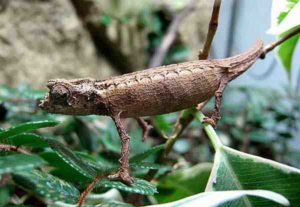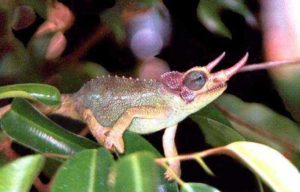A complex story

Over 200 chameleon species are currently recognised. And new species and even new genera are regularly being described as research provides a better understanding of this complex family.
Historically, people grouped chameleons into two types: true chameleons and false chameleons. This grouping has limitations. False chameleons, also known as pygmy or stump-tailed chameleons, contain only two genera: Rhampoleon from continental Africa and Brookesia from Madagascar.
The split into true and false chameleon species can appear confusing. Rhampholeons seem to be more closely related to other African continental chameleons such as Chamaeleo and Bradypodion than to Brookesias. Furthermore, Brookesias seem to have more in common with the Malagasy Calumma and Furcifer.
The Fischer’s chameleon illustrates how confusing chameleon classification has been in the past. For a long time, it was Chamaeleo fischeri. Then, for some strange reason, it became Bradypodion fischeri. Which was odd as this placed an egg laying species among a genus of predominantly live bearers.
In 2006 a new genus was created, Kinyongia, and the Fischer’s chameleon became known as Kinyongia fischeri.
Likewise, the strange-looking Bradypodion spinosum was evicted from that genus and moved to Rhampholeon, where it awaits further study.
DNA continues to help us understand the relationships between the various genera and different chameleon species. We can be confident that chameleon classification will continue to be almost as strange and complex as the animals themselves.
Distribution of chameleon species

Chameleons are primarily found on the African continent, as well as some islands nearby such as Seychelles and the Comoros. They are also found in Madagascar, the Arabian Peninsular, small parts of India, Sri Lanka and the most southern parts of Europe.
There are now thriving feral populations in other parts of the globe, notably the United States. The Jackson’s chameleon in Hawaii is the most famous, since its escape there in the early 1970s. It is now possible to find Veiled chameleons in parts of Florida and California.
